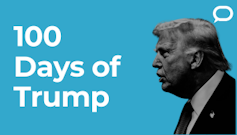economic uncertainty spikes while the president’s approval ratings tank
- Written by Steve Schifferes, Honorary Research Fellow, City Political Economy Research Centre, City St George's, University of London

When US president Donald Trump took office in January he inherited a strong economy[1], which was growing faster[2] than those of many of its rivals. Nevertheless, he won the election in November on the back of strong voter dissatisfaction with the economy, especially the cost of living. This is the legacy of high inflation sparked first by COVID and then Russia’s invasion of Ukraine.
But Trump also won with his appeal to “left-behind” voters, especially working-class people in the US rust belt[3]. This demographic has suffered a long-term decline in living standards as manufacturing jobs in traditional industries like car-making and steel have disappeared.
Trump claimed during his campaign that high tariffs[4] were the answer to most of America’s economic problems. He promised a revival in domestic manufacturing by blocking imports, while forcing foreign firms to shift production to the US. And there was also the promise of tax cuts[5] paid for with the revenues raised from tariffs.
But the erratic roll-out[6] of his tariff policies have shattered business[7] and consumer[8] confidence. They have also tanked his poll ratings[9] with respect to his management of the economy. And it is causing chaos to world trade and economic cooperation.
Trump’s popularity will suffer a further blow if Congress is forced to cut government spending even further to finance its tax cuts. One casualty could be Medicaid spending, which faces cuts of US$880 billion[19]. Medicaid provides health insurance for 70 million people on low incomes or with disabilities. The cut has already been included in one version of the budget resolution.
Read more: Trump thinks tariffs can bring back the glory days of US manufacturing. Here's why he's wrong[20]
Trump is now caught between his big business backers, who want to drastically reduce the role of the federal government but keep free trade, and his working-class supporters, who are hoping that his tariffs will restore manufacturing jobs.
But this group would be deeply upset by cuts to major government programmes such as Medicare and social security, which many depend on for much of their income. These programmes make up a large portion of all government non-defence spending, and without major cuts it will be hard to find enough savings to fund tax reductions.
With the International Monetary Fund[21] now forecasting a 40% chance of recession[22] in the US, the president’s economic ratings look unlikely to improve any time soon.
References
- ^ strong economy (edition.cnn.com)
- ^ growing faster (www.washingtonpost.com)
- ^ US rust belt (www.theguardian.com)
- ^ high tariffs (theconversation.com)
- ^ tax cuts (www.theguardian.com)
- ^ erratic roll-out (theconversation.com)
- ^ business (chiefexecutive.net)
- ^ consumer (www.theguardian.com)
- ^ tanked his poll ratings (edition.cnn.com)
- ^ weekly World Affairs Briefing newsletter (theconversation.com)
- ^ China (theconversation.com)
- ^ deal (theconversation.com)
- ^ US$4 trillion (www.reuters.com)
- ^ bond market (theconversation.com)
- ^ negotiated in Congress (www.bbc.co.uk)
- ^ attack (www.bbc.co.uk)
- ^ 2026 mid-term elections (centerforpolitics.org)
- ^ Christopher Penler/Shutterstock (www.shutterstock.com)
- ^ US$880 billion (www.cbsnews.com)
- ^ Trump thinks tariffs can bring back the glory days of US manufacturing. Here's why he's wrong (theconversation.com)
- ^ International Monetary Fund (theconversation.com)
- ^ 40% chance of recession (www.imf.org)







